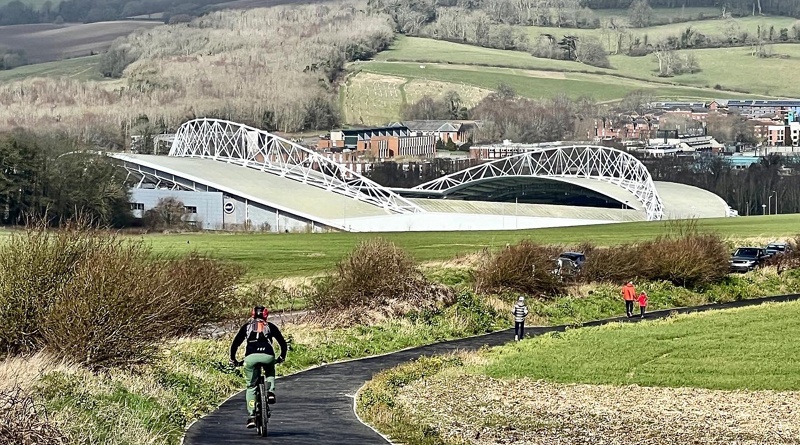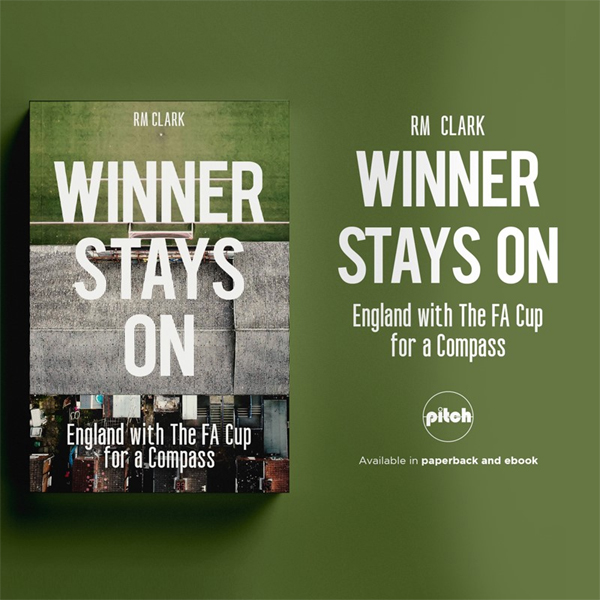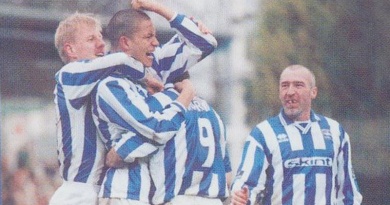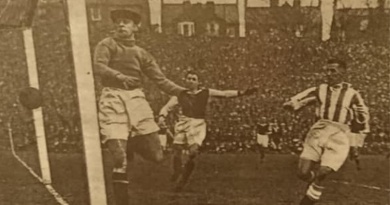Brighton, Bevendean, Grimsby and the Magic of the FA Cup
The 2022-23 season saw football fan R M Clark embark an odyssey around England, following the FA Cup from the extra preliminary round right the way through to the final.
It was a journey which took him from Tuffley Rovers to Burton Albion to Luton Town to a Manchester derby at Wembley Stadium.
Through 14 matches, Clark met football fans from all walks of life. He discovered the people and places that make the beautiful game and its most magical cup competition tick.
And then he wrote about it all. The result is a superb book, entitled Winner Stays On: England with The Cup for a Compass.
Having watched Grimsby Town eliminate Burton in round two, the League Two side’s fairy tale run in the competition meant Clark was to follow the Mariners all the way to the Amex.
The following extract is lifted from the 12th chapter of Winner Stays On: England with The Cup for a Compass, when Clark came to Brighton & Hove and ventured off the beaten track to discover a side to the city not many know exists.
Winner Stays On: England with The Cup for a Compass by R M Clark can be bought from Amazon using this link.
In North-East Brighton, two and a bit miles from the seafront, there is a network of banked, winding roads that climb across the landscape.
They are flanked on the one side by a golf course and a nature reserve, and on the other by a patchwork of fields leading off to the horizon.
Beyond that is the South Downs and a hundred miles of beds, breakfasts and bridleways. Perhaps, in another life, these winding roads too, could be lined with the colourful houses of the city beneath them, or by the wild, swaying palette of the land on its either side.
But today, they are the two lane veins of Moulsecoomb and Bevendean, a pair of adjacent estates whose invitation into the offbeat appears to have been lost in the post.
At the turn of the 20th century, Brighton was one of the most densely populated areas in England. Much of its housing was outdated, overcrowded, and unfit for purpose.
Worse than that though, it was harshing the mellow of an otherwise fashionable city; the slums sat in the heart of the town, bumping shoulders with Georgian grandeur and the daytripping Londoners who arrived via trains. And frankly, they were stinking the place out.
The council purchased new land on the outskirts, built hundreds of identikit houses, and scooped up all the poor folk with an arcade machine claw.
In the hundred years that followed, Brighton turned from a trendy town to a retirement home and back again, before being granted city status at the start of the new millennium. Moulsecoomb however, has remained both out of sight and out of time.
In 1935, a journalist at the Brighton Gazette wrote of “housewives with empty larders, of sick and ailing people in homes without the bare necessities of life, of children who sit a nights in lightless, fireless kitchens, because there is no money for the gas-meter, no coal for the grate.”
Visiting the area in the depths of a cost of living crisis – and having spent the previous two days in the comparatively utopian streets towards the seafront – I found it hard not to wonder how time can remain so still in one place whilst accelerating into a progressive future just two miles down the road.
Brighton today has the biggest inequality for life expectancy across the whole of the South East, and the rate of child poverty in Moulsecoomb is more than twice that of the city’s average. The working class may now have a bit more square footage, but in many ways they never escaped from the slums.
The Bevendean Hotel was opened in 1937, and spent the vast majority of its lifetime as a rough and unglamorous pub in a rough and unglamorous area.
One online review from 2010 described it as “rowdy at the weekend, full of men trying to buy young girls drinks, and old women making a fool of themselves because they think they’ve still ‘got it’.”
The police forced the pub to close down shortly afterwards, although that was more to do with the perpetual fisticuffs than the old girls and their denim skirts.
An estimated 18,000 people were left without a local, whilst the expensive bars, wineries and taprooms of the city centre were so far out of reach that they may as well have been on another planet.
“Although they’re being battered, and they’re all closing down – they’re still a part of people’s DNA”, said Warren Carter, Committee Chair at The Bevy, Moulsecoomb. “Watch any soap opera and it’ll all rotate around a pub.”
The opening scene of Sunday’s episode saw a hungover writer walk inside and ask for a coffee, to which the rough-edged but immediately recognisable softie behind the bar responded as though he had been asked to procure a freshly plucked goose, a natural and full-bodied Italian Lambrusco, and a freshly glazed creme brulee.
The next time the pair lay eyes on one another, the older man was atop the pub roof with a radio playing, whilst the younger man was on a tour of the pub’s back garden, and had recently learned that an outdoor composter runs to seventy degrees celsius and can be fed anything from mouldy vegetables to chicken bones.
The Bevy would be worthy of being described as a miracle, if only doing so wouldn’t discredit the hard work and endeavour of the people who have made it happen.
Warren’s favourite line is that “it’s a community centre where you can get pissed.” A place where darts teams rub shoulders with a gardening group; computer literacy sessions are followed by Jagerbombs.
Food was delivered to the vulnerable during lockdown; lectures are given free of charge by leading academics from the university.
The Friday Friends sessions invite the elderly along for a full dinner. If you can’t afford the petrol – or your hip won’t let you walk the hills – then someone will come round in a minibus and drop you back at your front door.
Over the past eight years, the pub has transformed from something that brought shame to the area – the local police’s first email to Warren said it would never be allowed to reopen – into being not just a community asset, but its defining one.
Above all else though, The Bevy is still just a pub. A glorious, welcoming, crucial – perfect, pub. Not for its eclectic selection of craft ales, nor for its fine dining, or Yorkshire puddings, or roaring fire or dusty signs, and not even for a full pint of Guinness, wobbling, defying physics above the rim of a glass.
The Bevy doesn’t have any of those things, but it is a place that knows its purpose; it knows that pub is short for public house, and that it is important above all else to live up to that title; to be open to the public, and provide the sanctuary of a home.
I first arrived at The Bevy at just gone eleven o’clock. There were maybe five other people inside, including Warren and the big softie roofer.
We were soon joined by Pat, an elderly, but nonetheless high-spirited man with an impressive white quiff and the unofficial title of pub grandad.
He was a model, well-respected gentleman of his generation, and he did not complainabout the lack of real Guinness (they’d had a problem with the gas the night before). Women kissed him on the cheek, men shook him by the hand. He and I stood together at the bar as strangers, and we talked.
Pat’s wife had suffered a stroke some years earlier, and it was one of the nurses who cared for her that first suggested that he pay a visit to The Bevy. After initial scepticism – “that’s in Moulsecoomb, ain’t it?” – he decided that there was no harm in trying it the once.
When I met him eight years later, we were joined at the bar by his neighbour; a tall and slightly vampiric man with a Brighton & Hove Albion scarf around his neck and both his and Pat’s match tickets on his phone.
But the pair didn’t talk as neighbours, nor as if the younger man was doing the older one a favour. Instead, they spoke as equals and as friends, and they included me within that warmth as if I had been there all along, across the road, two doors down – at the pub.
The pub that was full now, full of Brighton fans in scarves and shirts, talking of Forest away and the points system, Tuesday nights and a half-day off work and then, when the time came, dissecting the team sheet, on which De Zerbi had gone full strength, with only two changes made from their previous game.
If there had been any nervousness amongst the supporters before – and truthfully, I’m not convinced that there was – then it had certainly dissipated by now.
This was a team of soon-to-be superstars: Mitoma, MacAllister, Caicedo, Estunpinian, Dunk. Mac Allister had won the World Cup with Argentina only a matter of months earlier, and Caicedo was subject to a bidding war with Arsenal in the January just gone.
Mitoma, meanwhile, had studied the art of dribbling at university, and in the space of half a season, turned from a relatively unknown player – in Europe, at least – into one of the most exciting attacking talents in the country.
The bus ride to the ground was jovial, beautiful even. It felt like a scene from a sitcom, only with characters that wouldn’t age terribly if you tried to show them to your kids.
Everybody knew each other and everybody knew their own role: the old boy at the front who claimed he couldn’t sit in the back because it made him feel seasick, and the even older boy two rows behind, who took great delight in asking “where do you think we’re going? It’s only the Amex!”
We took childish, school trip joy in our access to the bus lane, ooooh-ing and aaaah-ing around the roundabout, rolling down the window and asking the policeman where the ground was; driving off laughing before he could reply.
It should be a human right to travel to football matches like this. Giddy, with your neighbours, free; from pub to ground in less than fifteen minutes.
Somehow, The Bevy and its regulars had managed to procure the best of both worlds: they watched beautiful, top-level football, and still retained a sense of the unrestricted freedoms and local, community-oriented stakes of the lower leagues too.
When it was reopened in 2014, The Bevy was the only community pub in the country to be found on a housing estate. As of my visit in March 2023 – eight life-enriching, example-setting, press-praising years later – this, somehow, was still the case.
Warren told me that there were around 200 other community pubs in the country. The obvious question was – where were they?
“There’s a few in London, there’s a big Spurs pub, there’s one up in Salford, but there’s none – none on an estate. And we’ve argued with funders and stuff because it’s so hard to do.”
“You can just imagine the paperwork and the hoops you have to jump through, and that’s just not the strong suit of some of these areas. It’s a real failure. And it’s the same old thing: the places with the most need find it the hardest to make it happen.”
“There’s this new community asset fund they’re talking about. They say they’re going to match the donations – but what good is that if you’ve got no donations to match?”
“I look at some of the pubs that have been funded in these posh villages and it just makes my gut go. They could as well have taken out a mortgage.”
“People come down here and say how amazing it is, but what’s amazing is that it’s been eight years and we’re still the only one. That’s amazing. That’s a failure of policy.”
I met Kieran outside the Amex. The stadium is submerged three storeys down into the ground, its exterior swoops all 360 degrees in one continuous motion, the roof appears as if drawn free-hand, protruding from the stadium to give a silhouette that falls somewhere been a UFO and a pringle.
As a building, it has much more in common with the football club than it does with the city. It is sleek, modern, and efficient, without a pastel colour or a drag queen in sight.
Brighton won comfortably. Evan Ferguson scored twice, Solly March, Kirou Mitoma and Denis Undav once. Grimsby were not embarrassed. They held their own, despite the scoreline, and even worked a handful of chances at the other end.
But they never looked for a moment as though they would win. It was one of those games; one of the dozens of foregone conclusions that makes the eventual upset worth waiting for. If every match was a surprise then none of them would be.
There were 89 years of drubbings between Grimsby’s previous FA Cup quarter final and this one; and though each exit might have stung at the time, there is perhaps an argument to be made to say that the stings were worth it. The wait may have been long, but the return was utterly joyous.
Harry Haddock was joined by a small army of fellow inflatables to be waved and thrown and bounced atop the crowd; from beach balls and blow-up dolls to flamingos and Zimmer frames, they rode the crested waves of woolly hats and specially commissioned scarves: HISTORY MAKERS, FA Cup Quarter Finalists 2023 V Brighton & Hove Albion.
Every song played on the PA was repurposed to the tune of Grimsby; every wayward shot jeered with such enthusiasm that you’d hardly believe their team were one, then two, then three, four, five-nil down. The scoreline didn’t matter. Both sides had got what they came for before a ball had even been kicked.
Barney Ronay wrote about the match for The Guardian. “Every year the FA Cup tells us the same thing,” he said. “How full of life the lower tiers of English football are, despite all that has been thrown at them.”
“The [football] Pyramid is often waved around the place like a holy relic, a set of footballing rosary beads. But there was evidence here also of the fun, the joy, the boisterous life of English football’s matchday culture.”
“Afternoons such as this are not an add-on or a clog in the schedule: this is the elite game’s basic power source, the layers below the layers.”
“Travelling away, finding a shared voice, bumping up against other human beings: this is why football works, why we get to have a billionaire‑backed global product, how this thing was built in the first place.”
Winner Stays On: England with The Cup for a Compass by R M Clark can be bought from Amazon using this link.





